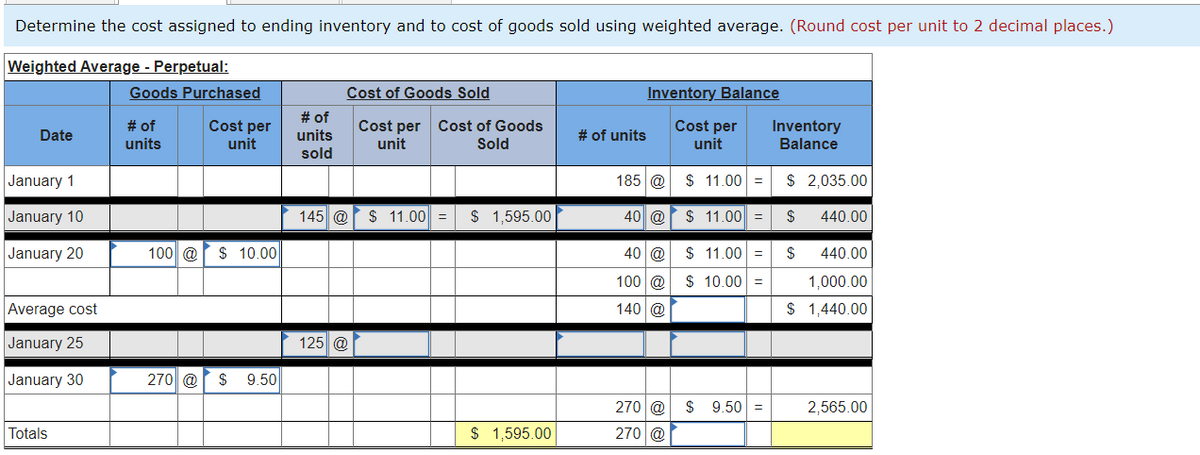Determine the cost assigned to ending inventory and to cost of goods sold using weighted average. (Round cost per unit to 2 decimal places.) Weighted Average - Perpetual: Goods Purchased Cost of Goods Sold Inventory Balance # of units Cost per unit # of units Cost per unit Cost of Goods Sold Cost per unit Inventory Balance Date # of units sold January 1 185 @ $ 11.00 = $ 2,035.00 January 10 145 @ $ 11.00 = $ 1,595.00 40 @ $ 11.00 = $ 440.00 January 20 100 @ $ 10.00 40 @ $ 11.00 = 440.00 100 @ $ 10.00 = 1,000.00 Average cost 140 @ $ 1,440.00 January 25 125 @ January 30 270 @ $ 9.50 270 @ $ 9.50 = 2,565.00 Totals $ 1,595.00 270 @
Determine the cost assigned to ending inventory and to cost of goods sold using weighted average. (Round cost per unit to 2 decimal places.) Weighted Average - Perpetual: Goods Purchased Cost of Goods Sold Inventory Balance # of units Cost per unit # of units Cost per unit Cost of Goods Sold Cost per unit Inventory Balance Date # of units sold January 1 185 @ $ 11.00 = $ 2,035.00 January 10 145 @ $ 11.00 = $ 1,595.00 40 @ $ 11.00 = $ 440.00 January 20 100 @ $ 10.00 40 @ $ 11.00 = 440.00 100 @ $ 10.00 = 1,000.00 Average cost 140 @ $ 1,440.00 January 25 125 @ January 30 270 @ $ 9.50 270 @ $ 9.50 = 2,565.00 Totals $ 1,595.00 270 @
Intermediate Accounting: Reporting And Analysis
3rd Edition
ISBN:9781337788281
Author:James M. Wahlen, Jefferson P. Jones, Donald Pagach
Publisher:James M. Wahlen, Jefferson P. Jones, Donald Pagach
Chapter7: Inventories: Cost Measurement And Flow Assumptions
Section: Chapter Questions
Problem 8P: Comprehensive The following information for 2019 is available for Marino Company: 1. The beginning...
Related questions
Topic Video
Question

Transcribed Image Text:Determine the cost assigned to ending inventory and to cost of goods sold using weighted average. (Round cost per unit to 2 decimal places.)
Weighted Average - Perpetual:
Goods Purchased
Cost of Goods Sold
Inventory Balance
# of
units
sold
# of
Cost per Cost of Goods
unit
Cost per
Cost per
Inventory
Balance
Date
# of units
units
unit
Sold
unit
January 1
185 @
$ 11.00 =
$ 2,035.00
January 10
145 @
$ 11.00 =
$ 1,595.00
40 @
$ 11.00 =
$
440.00
January 20
100 @
$ 10.00
40 @
$ 11.00 =
$
440.00
100 @
$ 10.00 =
1,000.00
Average cost
140 @
$ 1,440.00
January 25
125 @
January 30
270 @
$
9.50
270 @
$
9.50
2,565.00
Totals
$ 1,595.00
270 @
![Required information
Use the following information for the Exercises below.
[The following information applies to the questions displayed below.]
Laker Company reported the following January purchases and sales data for its only product.
Activities
Units Acquired at Cost
185 units @ $11.00 = $2,035
Date
Units sold at Retail
Jan. 1 Beginning inventory
Jan. 10 Sales
145 units @ $20.00
Jan. 20 Purchase
100 units @ $10.00 =
1,000
Jan. 25 Sales
125 units @ $20.00
Jan. 30 Purchase
270 units @ $ 9.50 =
2,565
Totals
555 units
$5,600
270 units
The Company uses a perpetual inventory system. For specific identification, ending inventory consists of 285 units, where
270 are from the January 30 purchase, 5 are from the January 20 purchase, and 10 are from beginning inventory.](/v2/_next/image?url=https%3A%2F%2Fcontent.bartleby.com%2Fqna-images%2Fquestion%2F6a02b260-ff6c-4d5e-84bc-57397ca3f648%2F61781942-744f-4146-a229-4a19166badbb%2Fdm9jppr_processed.png&w=3840&q=75)
Transcribed Image Text:Required information
Use the following information for the Exercises below.
[The following information applies to the questions displayed below.]
Laker Company reported the following January purchases and sales data for its only product.
Activities
Units Acquired at Cost
185 units @ $11.00 = $2,035
Date
Units sold at Retail
Jan. 1 Beginning inventory
Jan. 10 Sales
145 units @ $20.00
Jan. 20 Purchase
100 units @ $10.00 =
1,000
Jan. 25 Sales
125 units @ $20.00
Jan. 30 Purchase
270 units @ $ 9.50 =
2,565
Totals
555 units
$5,600
270 units
The Company uses a perpetual inventory system. For specific identification, ending inventory consists of 285 units, where
270 are from the January 30 purchase, 5 are from the January 20 purchase, and 10 are from beginning inventory.
Expert Solution
This question has been solved!
Explore an expertly crafted, step-by-step solution for a thorough understanding of key concepts.
This is a popular solution!
Trending now
This is a popular solution!
Step by step
Solved in 2 steps with 1 images

Knowledge Booster
Learn more about
Need a deep-dive on the concept behind this application? Look no further. Learn more about this topic, accounting and related others by exploring similar questions and additional content below.Recommended textbooks for you

Intermediate Accounting: Reporting And Analysis
Accounting
ISBN:
9781337788281
Author:
James M. Wahlen, Jefferson P. Jones, Donald Pagach
Publisher:
Cengage Learning

Century 21 Accounting Multicolumn Journal
Accounting
ISBN:
9781337679503
Author:
Gilbertson
Publisher:
Cengage

Financial Accounting: The Impact on Decision Make…
Accounting
ISBN:
9781305654174
Author:
Gary A. Porter, Curtis L. Norton
Publisher:
Cengage Learning

Intermediate Accounting: Reporting And Analysis
Accounting
ISBN:
9781337788281
Author:
James M. Wahlen, Jefferson P. Jones, Donald Pagach
Publisher:
Cengage Learning

Century 21 Accounting Multicolumn Journal
Accounting
ISBN:
9781337679503
Author:
Gilbertson
Publisher:
Cengage

Financial Accounting: The Impact on Decision Make…
Accounting
ISBN:
9781305654174
Author:
Gary A. Porter, Curtis L. Norton
Publisher:
Cengage Learning

College Accounting (Book Only): A Career Approach
Accounting
ISBN:
9781337280570
Author:
Scott, Cathy J.
Publisher:
South-Western College Pub

Financial Accounting
Accounting
ISBN:
9781337272124
Author:
Carl Warren, James M. Reeve, Jonathan Duchac
Publisher:
Cengage Learning
